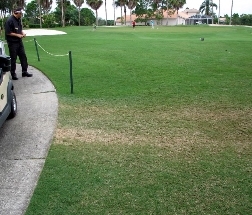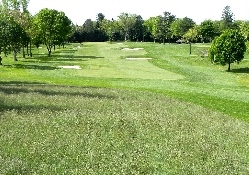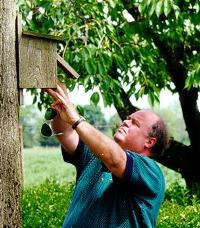|
|
|
|
|
November 18, 2011 -- Volume 49, Number 43
|
|
|
A 'Zero-Waste' Golf Course - Is It Possible?
| Dairy Creek Golf Club shows the way
by Patrick J. Gross, director, Southwest Region |
 | |
The composting facility at Dairy Creek is an important part of the program as they work toward being the first zero-waste golf course in the nation. Because of sanitation and health codes, special composting containers were necessary at Dairy Creek for decomposing non-vegetable food waste. With the covered bins, it is possible to incorporate up to 10% fats (meats and other food wastes) into the compost without causing problems with odor or vermin.
|
Grandpa used to say, "Waste not, want not." Dairy Creek Golf Club in San Luis Obispo, California, is taking that phrase literally and making efforts to become the first zero-waste golf facility in the nation. The overall goal is to recycle and reuse all products used at the golf facility and completely eliminate the need to haul any waste to a landfill. Dairy Creek is one of three county golf courses in San Luis Obispo under the direction of Golf Course Superintendent Josh Heptig. Josh became interested in the zero-waste concept and thought that with some planning and key partnerships, the principles that have been successfully applied by other businesses could work at a golf course. In addition, it could provide a valuable education and outreach component as part of a county-wide demonstration project.
The Zero-Waste Concept
According to the Zero Waste Alliance of Portland, Oregon, the overall goal of the concept is to eliminate solid waste, hazardous waste, toxics, and emissions and change our focus to looking at the byproducts generated in our daily lives as potential resources. In short, our waste products should have future applications and not simply end up in a landfill. Key to the program is choosing items used in our businesses and households with the end product in mind. As a result, there will be less risk to people and the environment, better efficiency, and lower overall costs.
Read the rest of this article.
|
| Have Your Fairways Ever Looked Like This? | Why does freeze damage occur to turfgrasses?
by Michelle DaCosta, Lindsey Hoffman, J. Scott Ebdon, and Eric Watkins |
 | |
Winter injury can result from direct low temperature kill, ice cover (suffocation), crown hydration, desiccation, and/or low temperature diseases (snow molds). (Photo credit: Alden Maddocks)
|
Whether you are growing ryegrass, bluegrass, bentgrass, zoysiagrass, or bermudagrass, they all run the risk of suffering severe damage from freezing temperatures. When freeze damage does occur to golf courses, invariably superintendents notice that there will be some patches of turf that are not injured while other patches are dead. What is it about some types (or clones) of grass that makes them better able to tolerate freezing temperatures?
Perrennial ryegrass (Lolium perenne) is a coolseason turfgrass species that is widely used on home lawns, sports fields, and golf courses due to its rapid establishment and superior traffic tolerance.
Compared to other cool-season turfgrasses, however, perennial ryegrass exhibits higher levels of freezing injury in northern climatic regions. Although there has been limited progress in the development of perennial ryegrass cultivars with improved winter hardiness, recent investigations from the University of Minnesota turfgrass breeding program have identified perennial ryegrass germplasm with superior freezing tolerance compared to many commercially available cultivars, suggesting that significant progress could be made toward the development of perennial ryegrass cultivars better adapted to northern climatic regions.
Read about this important research project.
|
Scientists In Golf
| Some of the most skilled "players" in golf are found in the laboratory
by the USGA Green Section staff |  We all enjoy watching the games top players on television. Through years of practice and hard work these individuals have risen to the top of their profession. Many golfers are unaware that there is another group of individuals in the game that have worked every bit as hard and as long to perfect their skills. These "pros" work to improve the course on which the game is played through their scientific knowledge and abilities. If you are a USGA member, you are helping to keep this team at the top of their game. We all enjoy watching the games top players on television. Through years of practice and hard work these individuals have risen to the top of their profession. Many golfers are unaware that there is another group of individuals in the game that have worked every bit as hard and as long to perfect their skills. These "pros" work to improve the course on which the game is played through their scientific knowledge and abilities. If you are a USGA member, you are helping to keep this team at the top of their game.
Dr. Michelle DaCosta is a turfgrass physiologist at the University of Massachusetts. She is one of many top scientists that receive USGA funding for the improvement of turfgrasses for golf courses. Michelle and her colleagues have discovered that some plants develop a compound that acts almost like a "plant antifreeze."
Click the Podcast link to listen to this brief telephone interview in which she describes her work and how she became interested in improving turfgrasses for golf.

Listen to the podcast
Read about this important research project.
|
|
Regional Updates
|  Florida Region Florida Region
by Todd Lowe, senior agronomist
| |
Dealing With Cart Traffic
 | |
Ropes and stakes are unpopular with golfers but effective at protecting the turf at this time of year.
|
The annual migration of northern golfers to our region has begun, and, with it, an influx of the number of rounds has occurred. This increase in rounds happens at a time of year when bermudagrass growth decreases, and these two factors combine for unsightly playing conditions.
Golfers are creatures of habit, often choosing the path of least resistance, and continual golfer traffic over the same area stresses turf conditions. The trodden leaves are not readily replaced with new, green leaves, and this creates yellow to tan coloration in affected areas. Eventually, the soil becomes compacted and poor turf conditions occur. The following steps should be taken at this time to protect turf and improve golf course quality:
Read the rest of this update
 Northeast Region Northeast Region
by Jim Skorulski, senior agronomist Winter Preparations  | |
Late fall offers an excellent opportunity to plant deciduous trees that are or near dormant. A large sugar maple tree is being carefully transplanted to a more favorable site at The Country Club last week.
|
It is hard to believe it is mid November with the Thanksgiving holiday right around the corner. This year provided heavy snow, spring flooding, 100 plus degree temperatures, a tornado, an earthquake, a tropical storm and hurricane, and a freak winter storm has many of us wondering: what's next? To say the extreme weather has taken its toll on the Northeast states is an understatement. The physical, emotional and financial strains have been difficult. The landscape in many areas has changed forever, and repairs and clean-up will continue for a long time. But life goes on and so too the preparations for the inevitable winter weather that is ahead. Read the rest of this update
 North Central Region North Central Region
by Bob Vavrek, senior agronomist
Got Drainage?  | |
(L) Visit a green during or right after heavy rainfall to document problem areas along the perimeter of the putting surface where an elevated collar or approach is impeding surface drainage. These sites will be highly susceptible to winterkill when frost is in the soil. (R) A heavy roller can be used to slowly lower the grade of slightly elevated collars and approaches that are impeding the movement of excess water off the putting surface.
|
Have you ever noticed an accumulation of water along the perimeter of a putting surface during and after a heavy mid-summer thunderstorm, especially where the green transitions into collar or approach? If so, these low, poorly drained sites can be highly susceptible to crown hydration or ice-suffocation winterkill. During summer, these perimeter puddles will disappear quickly as water percolates through the soil. However, these puddles can persist much longer when there is frost in the ground, and the combination of standing water plus cold temperatures is the classic recipe for severe winter injury.
Any combination of factors, such as poor design, poor construction technique, settling or an excessive accumulation of sand topdressing in the collar can hinder the flow of excess water off the putting surface. Regardless of why it occurs, it's not too late in the season to address at least a few of your green's worst perimeter drainage problems.
Options to consider include:
Read the rest of this update
 Northwest Region Northwest Region
by Larry Gilhuly, director
Asking The Right Questions
 During the Northwest Turfgrass Association meeting in Pullman, WA in late September, a very interesting and common-sense presentation was given by Mr. Bill Griffith, Director of the Walla Walla Community College Turf Management program. His talk was broken down into three distinct areas; decide what you need for the position you are seeking to fill, determining how to interview, and asking the right questions. For the sake of this update, the focus will be on the last portion of his presentation. During the Northwest Turfgrass Association meeting in Pullman, WA in late September, a very interesting and common-sense presentation was given by Mr. Bill Griffith, Director of the Walla Walla Community College Turf Management program. His talk was broken down into three distinct areas; decide what you need for the position you are seeking to fill, determining how to interview, and asking the right questions. For the sake of this update, the focus will be on the last portion of his presentation.
After spending hours researching various sites on this topic, Bill came up with very good questions that can help reveal not only the expertise of the person being interviewed, but who they are inside and how they react in situations found on a golf course. These questions are geared more for individuals seeking a management position; however, they are still very effective for filling any position. Here are the questions Bill delivered in his presentation that will assist you in selecting the best individual. Read the rest of this update. 
Mid-Continent Region
by Bud White, director
Mid-Continent Fall News Texas, New Mexico, and western Oklahoma are far from being over the drought, but at least we have experienced pleasantly mild temperatures this fall to give us good golfing weather. I encourage superintendents to continue irrigation cycles as long as there is any bermudagrass growth remaining. Hydrating the soil as best as possible is very beneficial to the bermudagrass as it goes dormant. We have put a package of materials together to help courses evaluate the drought in the lower Mid-Continent this year, and review recommended management programs. This is available at http://www.usga.org/news/2011/November/Dealing-With-The-Mid-Continent-Drought/. Let me remind you of the tree management webcast presented a few weeks ago by Dr. Todd Watson. The link to this webcast is noted below. If you have not seen this webcast, you will find it very informative about what we can expect from the drought. View the recorded webcast On another note, Texas is currently in the process of applying for a 24(c) label for Avid (abamectin) for nematode control. The 24(c) label is a temporary pesticide label granted to only a few states that have a very specific need for the material. Avid has been documented in North Carolina to provide nematode control, and other states, such as North Carolina, South Carolina, and Georgia, have acquired the 24(c) label. Superintendents need to be aware of this, so if you are called on by your local superintendent association to provide support letters for need of this material, please do so. Read the rest of this update.

Mid-Atlantic Region
by Stanley J. Zontek, director
The Value of Education
 | |
Great golf courses don't just 'happen.' It takes an educated staff to make an informed decision on how that golf course should look, play and be maintained. A view of Aronimink GC's Eleventh hole, including some of their work to convert parts of their rough to lower-maintenance fine fescue turf. Clearly, the program is working just fine.
|
I just heard the following comment, "I don't have time to attend turf conferences. I'm just too busy." Ironically, this was stated at a turf seminar! Here is the point.
I would argue that you should MAKE TIME to attend that conference, and further, bring along your assistant superintendent, general manager, green chairman, golf chairman, and anyone else in the club who would benefit from such a meeting. Here's why.
Although the "basics" of golf course turfgrass management never really change --- balanced and adequate fertility, growth of roots, management of water effectively, control weeds and diseases, control thatch, aerate and topdress --- it is the fine points of turfgrass management that are so important to learn and re-learn. At the very least, you can make an informed decision on what is best for you and your course.
With all of the stressful weather that most regions of our country have experienced this year, it is essential that you listen and learn about what worked and what didn't work. We are in a period of weather extremes, and the best way for your turf to survive is to grow healthy grass.
What's the new research on whether or not bacteria can actually affect golf turf? Is this a new problem to worry about? What's the latest on control of Poa annua? What about crabgrass and goosegrass control? Weed control in general...did you fight more weeds this year than past? If so, then you might need to change something or add something to your program to resolve the problems you now have. Clearly, what you may have done in the past may not work. Think about it, do you really NOT have the time to learn ways to solve the problems you have, for a better golf course next year? I would wager that you NEED to find time to attend these meetings.
Read the rest of this update.

Southwest Region
by Pat Gross, director
Cart Traffic On Overseeded Fairways And Rough
 | |
Allowing unrestricted cart traffic soon after overseeding can result in inferior surface quality throughout the winter and spring.
|
The biggest debate at this time in the Southwest Region is when to allow unrestricted golf cart use on newly overseeded fairways and rough. Superintendents are understandably protective of the young seedling turf, and golfers are equally passionate about driving their carts directly to the ball and not having to walk back and forth to the path. How do you decide when to turn the carts loose?
First, it is important to recognize that there is no objective standard for determining when the overseeded turf is strong enough to tolerate cart traffic.
Secondly, consider the fact that cart traffic never improves turf quality - it only makes it worse.
Lastly, the decision on whether to allow carts to drive on the fairways and rough is a qualitative judgment call.
To aid in making that judgment call, the following guideline can be used to gauge the length of time that carts should be restricted to the paths as part of the decision-making process:
Read the rest of this update.
|
|
Forward The Record To A Friend | It's Easy To Share This Publication With Others
by the USGA Green Section Staff | Each Green Section Record issue includes articles and information that appeal to golfers and those who work in the game. Please help us distribute this publication as widely as possible. The best way to do this is to click the "Forward to a Friend" button below.
Thanks for your help! |
| Green Section Record Archive | Looking for a previous issue of the Green Section Record?
|
 | |
Looking for something?
|
The Green Section Record has been published under various names since 1921 and is composed of an amazing collection of full-text articles and photos. This collection is stored and maintained by the wonderful library staff at Michigan State University in the Turfgrass Information File (TGIF). All past issues of the Record, including this one, can be accessed free-of-charge by following this link.
Search the Green Section Record |
|
The USGA Green Section Portal | A Valuable, Free Resource
|
Take a minute to visit the Green Section's portal at http://gsportal.usga.org to find information regarding upcoming live webcasts and links to recordings of more than 30 previously-delivered webcasts and announcements of upcoming USGA Green Section activities, education conferences, and meetings.
|
|
|
|
| USGA Green Section
P.O. Box 708
Far Hills, NJ 07931-0708
908.234.2300
| |

©2011 by United States Golf Association®
Permission to reproduce articles or material in the USGA Green Section Record is granted to
newspapers, periodicals, and educational institutions unless specifically noted otherwise. All materials
must be used in their entirety. Credit must be given to the author, the article's title, the USGA Green
Section Record, and the issue's date. Copyright protection must be afforded. No material may be
copied or used for any advertising, promotion or commercial purposes.
Green Section Record (ISSN 2156-5813) is published weekly via electronic mail by the
United States Golf Association®, Golf House, Far Hills, NJ 07931.
|
|
|
|
|
|